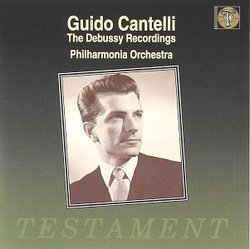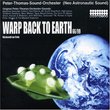| All Artists: Claude Debussy, Guido Cantelli, Philharmonia Orchestra of London Title: Guido Cantelli:The Debussy Recordings Members Wishing: 2 Total Copies: 0 Label: Testament UK Release Date: 10/27/1993 Album Type: Import Genre: Classical Styles: Chamber Music, Historical Periods, Classical (c.1770-1830), Modern, 20th, & 21st Century Number of Discs: 1 SwapaCD Credits: 1 UPC: 749677101121 |
Search - Claude Debussy, Guido Cantelli, Philharmonia Orchestra of London :: Guido Cantelli:The Debussy Recordings
 | Claude Debussy, Guido Cantelli, Philharmonia Orchestra of London Guido Cantelli:The Debussy Recordings Genre: Classical
There may be more atmospheric and individualized versions of these works in the catalog, but few that merge refinement of sonority, fidelity to the score, proportion, and impeccable taste to the degree that Guido Cantelli ... more » |
Larger Image |
CD DetailsSynopsis
Amazon.com There may be more atmospheric and individualized versions of these works in the catalog, but few that merge refinement of sonority, fidelity to the score, proportion, and impeccable taste to the degree that Guido Cantelli achieves here. EMI's early fifties mono engineering needs no disclaimer. One of the truly great orchestral recordings of all time. --Jed Distler Similar CDs
|
CD ReviewsMore Classic Cantelli Michael B. Richman | Portland, Maine USA | 01/06/2004 (5 out of 5 stars) "Had Guido Cantelli not died in an airplane crash in 1956 at the tender age of 36, he would undoubtedly be known today as one of the world's most famous conductors. As is, collectors regard him as one of the greatest conductors of the 20th Century, and these vintage EMI recordings, reissued by the Testament label, show why. "The Debussy Recordings" collects all of Cantelli's late mono performances of the composer's works with the Philharmonia Orchestra -- two of the three "Nocturnes" ("Nuages" and "Fetes," 8/55), "Prelude a l'apres-midi d'un faune" (6/54), the Fragments symphoniques from "Le Martyre de Saint-Sebastien" (6/54) and "La Mer" (9/55). Cantelli made a surprisingly large number of recordings for EMI in the early 1950s and most of them have been reissued at some point on CD (by both EMI and Testament), yet many of them are now out-of-print. Classical fans curious about Cantelli's considerable skills should pick up this title before it suffers a similar fate." ATMOSPHERE DAVID BRYSON | Glossop Derbyshire England | 12/19/2009 (5 out of 5 stars) "How `impressionistic' should we expect performances of Debussy to be? It seems to me that it's best not to over-generalise. For one thing, he does not often explicitly admit to representing the non-musical world in his music: more often the music itself suggests some vaguer mental association which he denotes by a `title' placed at the end of the piece. Critics and commentators also seem to talk about Debussy as `impressionistic' without in many cases implying anything specific in the impression. What seems to be meant is a certain kind of aura or atmosphere surrounding the music, and performances of Debussy are often assessed according to the extent that they convey this impression. However when all is said and done Debussy is far more than a great impressionist. He is an enormously great composer and musician, and that is the overwhelming `impression' that I am left with by this Cantelli disc.
Cantelli's great mentor was Toscanini, and the liner note records a statement by Toscanini as he listened to the younger man conduct that he seemed to be hearing himself as he listened. In what I know of Cantelli's work I have not detected much affinity with Toscanini's way of doing things (with a possible exception that I shall talk about in Fetes), and the only Debussy that I know from both of them is La Mer. In this case Cantelli is not the slightest bit like Toscanini, whose interpretation came in for a good deal of criticism alleging `lack of atmosphere'. Whether or not one agrees with this criticism or with the liner-note writer here who argues that Toscanini was evoking a different kind of atmosphere, there is no doubt that Cantelli is more in line with the mainstream view of how to perform Debussy. Now switch the comparison from Toscanini to certain other eminent conductors, and a very different picture starts to form. The difference is most marked in the prelude to L'Apres-midi d'un Faune, where my benchmark performance down the years has been from Beecham. This really is a case where the music is overtly representational and descriptive. It is also `atmospheric' in the extreme, and from Beecham one senses the heavy windless air and the erotic sense of languor. There is a more innocent sense about it all from Cantelli. His performance is full of sensitivity and sympathy, the playing of the incomparable Philharmonia is unsurpassable, but in the last resort it's surely Beecham who is the real deal. Despite that, I can't shake off a fascination with the way Cantelli handles it. This is Debussy with a very slightly unfamiliar accent, but an accent that I find extremely attractive. The four St Sebastien `symphonic fragments' might be thought similar, with their not very veiled homoerotic sense. Here my comparison is with Monteux, and I don't in the event find a lot to choose between him (with the LSO in 1963 and available on a mixed Debussy disc from various conductors on the Philips Eloquence label) and Cantelli. Again Cantelli's sound is more open, but there is not really much in it. The approach of both maestri is broadly similar, and there is no way that anyone would go wrong with either. The Nocturnes present perhaps the most interesting case. There are only two of the three here, and indeed it appears that Cantelli never performed Sirenes, whether because of its wordless choral element or for some other reason. The comparison that I conducted here was with what is widely acknowledged to be one of the finest Debussy discs since (and indeed probably also before) Cantelli's time, namely Haitink's award-winning performance on another Philips disc from 1980 which also contains the marvellous and rarely heard ballet Jeux. In Fetes I actually found myself awarding my own prize to Cantelli. Quite obviously this is not where one would look for nebulous atmospherics, languor or that sort of thing. Two things have me preferring Cantelli, one is his handling of the fortissimo section, and you may think that my criterion here is not of the loftiest. It is simply the terrific discipline of the orchestral playing. I feel sure that Cantelli started with a gift for obtaining that, and if it needed any developing Toscanini would have supplied the necessary impetus. Beecham despised Toscanini as `an Italian bandmaster', but there is a time and a place for everything, and it is precisely Cantelli's bandmaster talent that has me thrilled here. The other thing that impresses me particularly is the remote sound of the trumpets just previously, although to what extent the credit belongs to the director and to what extent to the recording engineers I would not like to say. Nuages brings me back to the basic theme of this review. It is the first thing on the disc, and for that reason it will be likely to inspire many listeners' first reaction to Cantelli's Debussy. There is much more sense of sky and air surrounding these clouds than in Haitink's reading, and of course it was Haitink's approach that so impressed the adjudicators in 1980. For all that, I once again take strongly to Cantelli's interpretation. The reason for that is probably what I suggested at the outset, namely that I found my attention being drawn less to the impressionism and more to the actual musical content of the piece, and how wonderful that is. It is all helped of course by the superlative orchestral playing. I'm sure that in its heyday the Philharmonia was unequalled among orchestras, and if you choose not to take my word for that then take Toscanini's. The recording (ADD/MONO) is startlingly good, and there is even a good liner note. We lost a lot when Cantelli died in that Paris air crash in 1956, but thankfully there is still a significant legacy, a monument to him and an inspiration to the rest of us." |

 Track Listings (10) - Disc #1
Track Listings (10) - Disc #1


